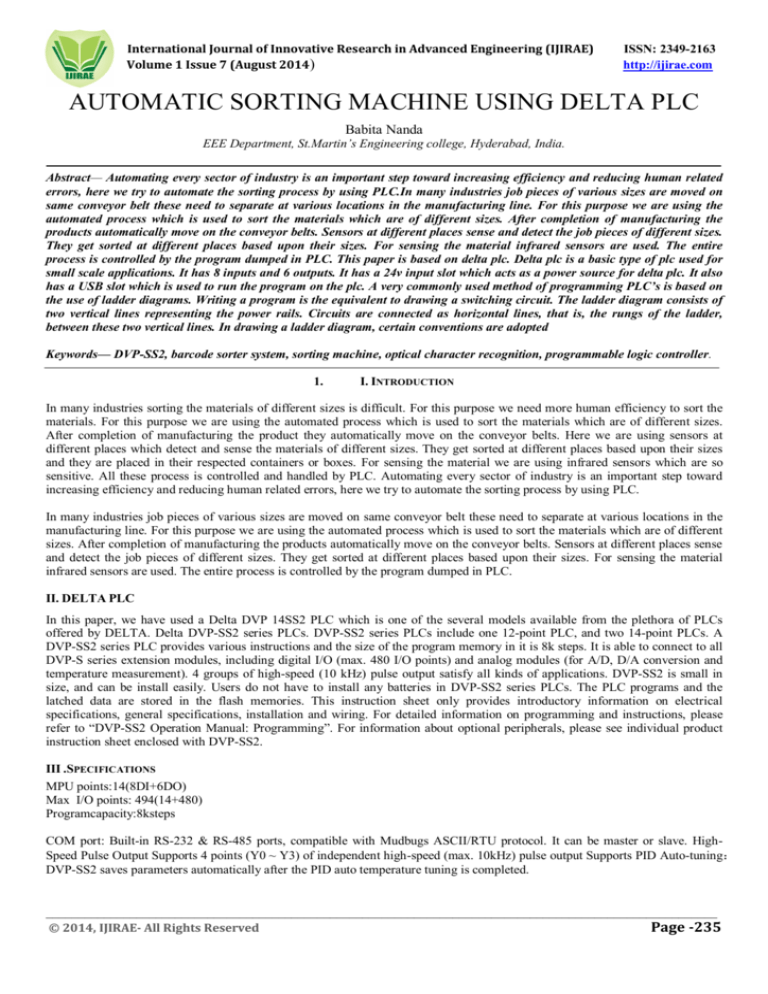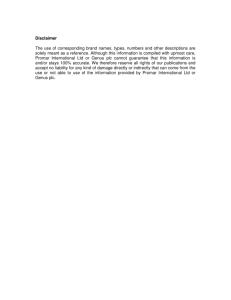
International Journal of Innovative Research in Advanced Engineering (IJIRAE)
Volume 1 Issue 7 (August 2014)
ISSN: 2349-2163
http://ijirae.com
AUTOMATIC SORTING MACHINE USING DELTA PLC
Babita Nanda
EEE Department, St.Martin’s Engineering college, Hyderabad, India.
Abstract— Automating every sector of industry is an important step toward increasing efficiency and reducing human related
errors, here we try to automate the sorting process by using PLC.In many industries job pieces of various sizes are moved on
same conveyor belt these need to separate at various locations in the manufacturing line. For this purpose we are using the
automated process which is used to sort the materials which are of different sizes. After completion of manufacturing the
products automatically move on the conveyor belts. Sensors at different places sense and detect the job pieces of different sizes.
They get sorted at different places based upon their sizes. For sensing the material infrared sensors are used. The entire
process is controlled by the program dumped in PLC. This paper is based on delta plc. Delta plc is a basic type of plc used for
small scale applications. It has 8 inputs and 6 outputs. It has a 24v input slot which acts as a power source for delta plc. It also
has a USB slot which is used to run the program on the plc. A very commonly used method of programming PLC’s is based on
the use of ladder diagrams. Writing a program is the equivalent to drawing a switching circuit. The ladder diagram consists of
two vertical lines representing the power rails. Circuits are connected as horizontal lines, that is, the rungs of the ladder,
between these two vertical lines. In drawing a ladder diagram, certain conventions are adopted
Keywords— DVP-SS2, barcode sorter system, sorting machine, optical character recognition, programmable logic controller.
1.
I. INTRODUCTION
In many industries sorting the materials of different sizes is difficult. For this purpose we need more human efficiency to sort the
materials. For this purpose we are using the automated process which is used to sort the materials which are of different sizes.
After completion of manufacturing the product they automatically move on the conveyor belts. Here we are using sensors at
different places which detect and sense the materials of different sizes. They get sorted at different places based upon their sizes
and they are placed in their respected containers or boxes. For sensing the material we are using infrared sensors which are so
sensitive. All these process is controlled and handled by PLC. Automating every sector of industry is an important step toward
increasing efficiency and reducing human related errors, here we try to automate the sorting process by using PLC.
In many industries job pieces of various sizes are moved on same conveyor belt these need to separate at various locations in the
manufacturing line. For this purpose we are using the automated process which is used to sort the materials which are of different
sizes. After completion of manufacturing the products automatically move on the conveyor belts. Sensors at different places sense
and detect the job pieces of different sizes. They get sorted at different places based upon their sizes. For sensing the material
infrared sensors are used. The entire process is controlled by the program dumped in PLC.
II. DELTA PLC
In this paper, we have used a Delta DVP 14SS2 PLC which is one of the several models available from the plethora of PLCs
offered by DELTA. Delta DVP-SS2 series PLCs. DVP-SS2 series PLCs include one 12-point PLC, and two 14-point PLCs. A
DVP-SS2 series PLC provides various instructions and the size of the program memory in it is 8k steps. It is able to connect to all
DVP-S series extension modules, including digital I/O (max. 480 I/O points) and analog modules (for A/D, D/A conversion and
temperature measurement). 4 groups of high-speed (10 kHz) pulse output satisfy all kinds of applications. DVP-SS2 is small in
size, and can be install easily. Users do not have to install any batteries in DVP-SS2 series PLCs. The PLC programs and the
latched data are stored in the flash memories. This instruction sheet only provides introductory information on electrical
specifications, general specifications, installation and wiring. For detailed information on programming and instructions, please
refer to “DVP-SS2 Operation Manual: Programming”. For information about optional peripherals, please see individual product
instruction sheet enclosed with DVP-SS2.
III .SPECIFICATIONS
MPU points:14(8DI+6DO)
Max I/O points: 494(14+480)
Programcapacity:8ksteps
COM port: Built-in RS-232 & RS-485 ports, compatible with Mudbugs ASCII/RTU protocol. It can be master or slave. HighSpeed Pulse Output Supports 4 points (Y0 ~ Y3) of independent high-speed (max. 10kHz) pulse output Supports PID Auto-tuning:
DVP-SS2 saves parameters automatically after the PID auto temperature tuning is completed.
________________________________________________________________________________________________________
© 2014, IJIRAE- All Rights Reserved
Page -235
International Journal of Innovative Research in Advanced Engineering (IJIRAE)
Volume 1 Issue 7 (August 2014)
ISSN: 2349-2163
http://ijirae.com
Electrical Specifications of Delta DVP-14SS2
________________________________________________________________________________________________________
© 2014, IJIRAE- All Rights Reserved
Page -236
International Journal of Innovative Research in Advanced Engineering (IJIRAE)
Volume 1 Issue 7 (August 2014)
ISSN: 2349-2163
http://ijirae.com
IV. INPUT / OUTPUT CONFIGURATIONS
V .DIMENSION & INSTALLATION
Direct Mounting : Using M4 screw according to dimension of the product
DIN Rail Mounting: When mounting a PLC to DIN rail we use the retaining clip to stop any side to side movement of
the PLC and reduce the chances of wire being loose.
Wiring: Using 22-16 AWG single or multiple core wire on I/O wiring terminals as shown in the figure below.
PLC terminal screws should be tightened to 1.90 Kg –cm
________________________________________________________________________________________________________
© 2014, IJIRAE- All Rights Reserved
Page -237
International Journal of Innovative Research in Advanced Engineering (IJIRAE)
Volume 1 Issue 7 (August 2014)
ISSN: 2349-2163
http://ijirae.com
VI. POWER SUPPLY
The power input of DVP-SS2 is DC. When operating DVP-SS2, please note the following points
The power is connected to two terminals. 24V DC and 0V and the range of power is 20.4 – 28.8 V DC. If the power
voltage is less than 20.4 V DC, the PLC will stop running and all outputs will be OFF and the error indicator will start
blinking.
Power shutdown for less than 10ms will not affect the operation of the PLC. However the shutdown that is too long or
the drop of the power voltage will stop the operation of the PLC and all outputs will go OFF. When the power returns to
normal status, the PLC will automatically resume the operation
There are 2 types of DC inputs, SINK and SOURCE
1.
DC Signal – SINK mode
Fig : Input point loop equivalent circuit
________________________________________________________________________________________________________
© 2014, IJIRAE- All Rights Reserved
Page -238
International Journal of Innovative Research in Advanced Engineering (IJIRAE)
Volume 1 Issue 7 (August 2014)
2.
ISSN: 2349-2163
http://ijirae.com
DC Signal – SOURCE mode
Fig : Input point loop equivalent SOURCE
VII. OUTPUT POINT WIRING
DVP SS2 has two output modules in it, relay and transistor. Output terminals Y0, Y1 and Y2 of relay models use C0
common port. Y3, Y4 and Y5 use C1 common port. When the output points are enabled, their corresponding indicators on the
front panel will be ON
The output terminals Y0-Y5 (NPN) of the transistor model are connected to the common terminals UP and ZP. The
output terminals Y0-Y3 (PNP) model is connected to the terminals UP and ZP.
Isolation circuit : the optical coupler is used to isolate signals between the circuit inside the PLC and input modules
VIII. RELAY OUTPUT CIRCUIT WIRING
________________________________________________________________________________________________________
© 2014, IJIRAE- All Rights Reserved
Page -239
International Journal of Innovative Research in Advanced Engineering (IJIRAE)
Volume 1 Issue 7 (August 2014)
ISSN: 2349-2163
http://ijirae.com
1 – DC power supply
2 - Emergency stop: using external switch
3 – Fuse: Uses 5-10 A fuses at the shared terminal of the output contacts to protect the output circuit
4 – Transient voltage suppressor: Extends the life span of contact
Diode suppression of DC load : Used when in smaller power
Diode + zener suppression of DC load : Used when in larger power and frequent ON/OFF
5 – Incandescent Light
6 – AC power supply
7 – Manually exclusive output , for example Y3 and Y4 control the forward running and reverses running of the motor, forming
an interlock with the external circuit along with the PLC internal program to ensure safe protection in case of any unexpected
errors.
8 – Absorber – Reduces the interference on AC load
IX. TRANSISTOR OUTPUT CIRCUIT WIRING
1 – DC power supply
2 – Emergency stop
3– Circuit protection fuse
4 – The output of the transistor model is “open collector”: If Y0/Y1 is set to pulse output, the output current has to be bigger than
0.1 A to ensure normal operation of the model.
Diode suppression is used in the smaller power and diode + zener is used in larger power and frequent On/Off
5 – Manually exclusive output – for e3xample Y2 and Y3 control the forward running and reverse running of the motor forming
an interlock for the external circuit together with the PLC internal program to ensure safe protection in case of unexpected errors
This paper is based on delta plc. Delta plc is a basic type of plc used for small scale applications. It has 8 inputs and 6 outputs. It
has a 24v input slot which acts as a power source for delta plc. It also has a USB slot which is used to run the program on the plc.
________________________________________________________________________________________________________
© 2014, IJIRAE- All Rights Reserved
Page -240
International Journal of Innovative Research in Advanced Engineering (IJIRAE)
Volume 1 Issue 7 (August 2014)
ISSN: 2349-2163
http://ijirae.com
X.CIRCUIT DESCRIPTION
XI. LADDER PROGRAMME
A ladder diagram is read from left to right and from top to bottom. Fig 4.4 shows the scanning motion employed by the PLC. The
top rung is from left to right. Then the second rung is read from left to right and so on. When the PLC is in its run mode, it goes
through the entire ladder program to the end, the second rung of the program being clearly denoted, and then promptly resumes at
the start. This procedure of going through all the rungs of the program is termed as cycle. The end rung might be indicated by a
block with the word END or RET, for return, since the program promptly returns to its beginning. The scan time depends on the
no. of rungs in the program taking about 1ms for 1000 bytes of program and typically ranging about 10ms up to 50ms.
The inputs and outputs are all identified by their addresses; the notation used depends on the PLC manufacturer. This is the
address of the input or output in the memory of the PLC. Figure below shows standard IEC 1131-3 symbols that are used for input
and output devices. Some slight variations occur between the symbols when used in semi graphic form and when in full graphic,
the semi graphic form being the one created by simply typing using the normal keyboard, whereas the graphic form is the result of
using drawing tools.
________________________________________________________________________________________________________
© 2014, IJIRAE- All Rights Reserved
Page -241
International Journal of Innovative Research in Advanced Engineering (IJIRAE)
Volume 1 Issue 7 (August 2014)
ISSN: 2349-2163
http://ijirae.com
X.EXPERIMENTAL SET UP
XI. CONCLUSION
Implementing of Delta PLC for shorting of machine has greatly reduced the complexity involved in completing this project .Every
production unit of mass production can make use of this king of system. Many more industries can be identified for the application
of this system.
REFERENCES
[1] https://en.wikipedia.org/wiki/Programmable_logic_controller
[2] http://www.ecgf.uakron.edu/grover/web/ee491/labs/SFC%20Traffic%20Light%20Controller.pdf
[3] http://www1.labvolt.com/publications/Courseware_Samples/85249_F0.pdf
[4] en.wikibooks.org/wiki/Introductory_ PLC _Programmingwww.plcmanual.com/
[5] PLC by W. Bolton
________________________________________________________________________________________________________
© 2014, IJIRAE- All Rights Reserved
Page -242







